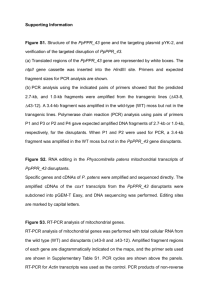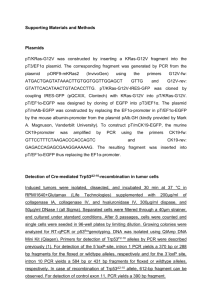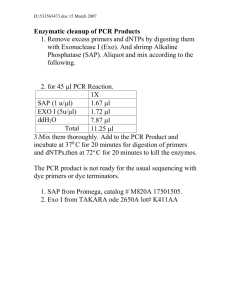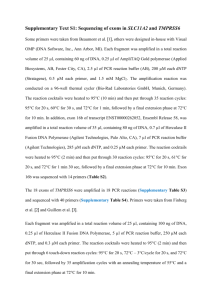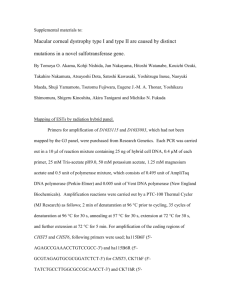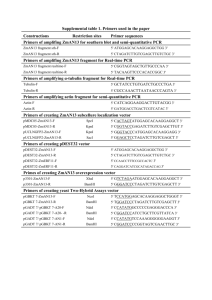Supplementary Information (doc 59K)
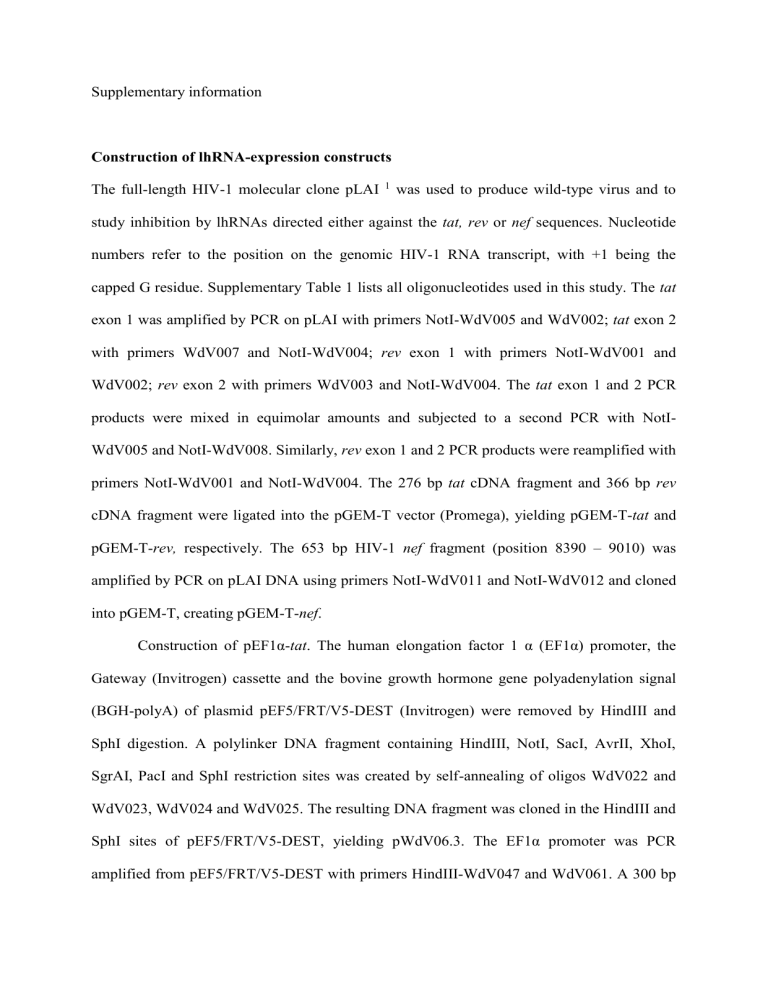
Supplementary information
Construction of lhRNA-expression constructs
The full-length HIV-1 molecular clone pLAI 1 was used to produce wild-type virus and to study inhibition by lhRNAs directed either against the tat, rev or nef sequences. Nucleotide numbers refer to the position on the genomic HIV-1 RNA transcript, with +1 being the capped G residue. Supplementary Table 1 lists all oligonucleotides used in this study. The tat exon 1 was amplified by PCR on pLAI with primers NotI-WdV005 and WdV002; tat exon 2 with primers WdV007 and NotI-WdV004; rev exon 1 with primers NotI-WdV001 and
WdV002; rev exon 2 with primers WdV003 and NotI-WdV004. The tat exon 1 and 2 PCR products were mixed in equimolar amounts and subjected to a second PCR with NotI-
WdV005 and NotI-WdV008. Similarly, rev exon 1 and 2 PCR products were reamplified with primers NotI-WdV001 and NotI-WdV004. The 276 bp tat cDNA fragment and 366 bp rev cDNA fragment were ligated into the pGEM-T vector (Promega), yielding pGEM-Ttat and pGEM-Trev, respectively. The 653 bp HIV-1 nef fragment (position 8390 – 9010) was amplified by PCR on pLAI DNA using primers NotI-WdV011 and NotI-WdV012 and cloned into pGEM-T, creating pGEM-Tnef .
Construction of pEF1αtat . The human elongation factor 1 α (EF1α) promoter, the
Gateway (Invitrogen) cassette and the bovine growth hormone gene polyadenylation signal
(BGH-polyA) of plasmid pEF5/FRT/V5-DEST (Invitrogen) were removed by HindIII and
SphI digestion. A polylinker DNA fragment containing HindIII, NotI, SacI, AvrII, XhoI,
SgrAI, PacI and SphI restriction sites was created by self-annealing of oligos WdV022 and
WdV023, WdV024 and WdV025. The resulting DNA fragment was cloned in the HindIII and
SphI sites of pEF5/FRT/V5-DEST, yielding pWdV06.3. The EF1α promoter was PCR amplified from pEF5/FRT/V5-DEST with primers HindIII-WdV047 and WdV061. A 300 bp
antisense tat (astat ) DNA fragment was PCR amplified from pGEM-Ttat with primers
WdV049 and NotI-WdV050. The EF1α and astat fragments were mixed and subjected to a second PCR with primers HindIII-WdV047 and NotI-WdV050, and ligated into the HindIII and NotI sites of pWdV06.3 to yield pWdV17. The BGH-polyA was amplified by PCR on pEF5/FRT/V5-DEST with primers WdV053 and PacI-WdV054. A 300 bp sense tat (stat )
DNA fragment was PCR amplified from pGEM-Ttat with primers AvrII-WdV051 and
WdV52. The stat and BGH-polyA fragments were mixed and re-amplified by PCR with
AvrII-WdV051 and PacI-WdV054 and cloned in the AvrII and PacI sites of pWdV17, yielding pEF1αtat (Fig. 3).
Construction of pEF1αrev.
The EF1α promoter was amplified by PCR on pEF5/FRT/V5-DEST with primers HindIII-WdV047 and WdV055. A 300 bp anti-sense rev
(asrev ) fragment was PCR amplified from pGEM-Trev with primers WdV056 and NotI-
WdV057. Both EF1α and asrev fragments were mixed and subjected to a second PCR with
HindIII-WdV047 and NotI-WdV057. The resulting fragment was ligated into the HindIII and
NotI sites of pWdV06.3, yielding pWdV19. The BGH-polyA was amplified by PCR on pEF5/FRT/V5-DEST with primers WdV60 and PacI-WdV054. A 300 bp sense rev (srev ) was PCR amplified from pGEM-Trev with primers AvrII-WdV058 and WdV059. The srev and BGH-polyA fragments were mixed and re-amplified by PCR with AvrII-WdV058 and
PacI-WdV054 and the resulting fragment was ligated in the AvrII and PacI sites of pWdV19 to yield pEF1αrev (Fig. 3).
Construction of pEF1αnef1.
The EF1α promoter was PCR amplified from pEF5/FRT/V5-DEST with primers HindIII-WdV047 and WdV061. A 300 bp anti-sense nef1
(asnef1 ) fragment was amplified by PCR on pGEM-Tnef with primers WdV062 and NotI-
WdV063. The EF1α and asnef1 fragments were fused by PCR with primers HindIII-
WdV047 and NotI-WdV063 and cloned into the HindIII/NotI sites of pWdV06.3 to yield
pWdV21. The BGH-polyA was amplified by PCR on pEF5/FRT/V5-DEST with primers
WdV066 and PacI-WdV054. A 300 bp sense nef1 (snef1 ) fragment was PCR amplified from pGEM-Tnef with primers AvrII-WdV064 and WdV065. Both BGH-polyA and snef fragments were mixed and re-amplified by PCR with primers AvrII-WdV064 and PacI-
WdV054 and cloned into likewise digested pWdV21, yielding pEF1αnef1 (Fig. 3).
Construction of pEF1α-GFP. A DNA fragment comprising the hrGFP gene was PCR amplified from PSXrabpA (Stratagene) with primers attB1-WdV020 and attB2-WdV021. The hrGFP was recombined into pEF5/FRT/V5-DEST using the Gateway technology, resulting in the hrGFP gene expression vector pHY01. The EF1α promoter was amplified by PCR on pEF5/FRT/V5-DEST with primers SphI-WdV034 and WdV035. A second PCR was performed to amplify the hrGFP fragment from pHY01 with primers WdV036 and BamHI-
WdV037. Both EF1α and hrGFP fragments were mixed and subjected to a PCR with SphI-
WdV034 and BamHI-WdV037 and the resulting PCR product was ligated into SphI and
BamHI sites of pUC19 to yield pWdV09. An antisense fragment from hrGFP (as-hrGFP) gene was amplified by PCR on pHY01 with primers BamHI-WdV038 and WdV039. A second PCR was performed to amplify an SV40-polyA (SV40-pA) fragment from plasmid pPUR (Clontech) using primers WdV040 and EcoRI-WdV041. as-hrGFP and SV40-pA fragments were mixed and subjected to PCR with BamHI-WdV038 and EcoRI-WdV041. The resulting fragment was ligated into the BamHI and EcoRI sites of pWdV09, yielding pWdV10. pWdV10 was digested with SphI and the fragment containing the GFP inverted repeat was ligated in the likewise digested pHY01 plasmid to yield pEF1α-GFP (Fig. 3).
Construction of pLTRtat, pLTRnef1 , p7tetOtat and p7tetOnef1.
The HIV-1 LTR was PCR amplified from pBlue3’LTR-luc
2
with primers SalI-PKF5 and HindIII-PKR5;
7tetO was amplified from the CMV-7tetO promoter/luciferase reporter construct pUHC13-3 3 with primers SalI-PKF6 and HindIII-PKR6. Both LTR and 7tetO amplicons were cloned in
the SalI and HindIII sites of pBluescript SK- (Stratagene) to yield pBlue-LTR and pBlue-
7tetO, respectively. To create the lhRNA tat and n ef1 , approximately 300 nt astat and asnef1 fragments were PCR amplified from pEF1αtat and pEF1αnef1 with primers HindIII-PKF4 and NotI-PKR2, and cloned into the HindIII and NotI sites of pBlue-LTR and pBlue-7tetO, resulting in pLTRastat, pLTRasnef1 , p7tetOastat and p7tetOasnef1 . Two oligos PKF8 and
PKR13 were self-annealed to create a polylinker NotI-MunI-BsaBI-XbaI-AvrII-SacII-
BamHI-EcoRV-BbrPI-SacII that was ligated in the NotI and SacII sites of the above pLTR- and 7tetO-containing plasmids. The intron of the EF1α promoter was amplified from pWdV65 with primers MunI-PKF13 and XbaI-PKR9 and ligated in the MunI and XbaI sites of the polylinker. The stat and snef1 fragments, together with the BGH-polyA, were amplified from pEF1αtat and pEF1αnef1 with primers PKF2 and BamHI-PKR4 and cloned into the AvrII and BamHI sites downstream of the EF1α intron, resulting in pLTRtat , pLTRnef1 , p7tetOtat , and p7tetOnef1 (Fig. 3) . Vector pLTR
nef1 (Fig. 3) was created by insertion of the 554 nt HindIII fragment of pLAI (
, 76 - 630) into the corresponding site of pLTRnef1. The Ψ fragment includes the HIV-1 polyA signal, primer-binding site, dimerisation signal, splice donor site and packaging signal. Plasmid pLTR
has been described previously
4
.
Construction of pT7nef2 and pT7shnef.
Plasmid pGEM-Tnef was PCR amplified with primers SacI-T7p-PKF16 and asT7p-XbaI-PKR16. The resulting nef2 PCR product that contains convergent T7 promoters and terminators was cloned in pCR2.1-TOPO (Invitrogen) to yield pT7nef2 (Fig. 3). Plasmid pT7shnef was constructed by self-annealing of two complementary oligos NcoI-PKF21 and BamHI-PKR21 that were cloned into the NcoI andBamHI sites of pT7-luc (
5,6
, a kind gift of Dr. P. Midoux, Centre de Biophysique
Moleculaire, Orleans, France), replacing the Photinus pyralis luciferase (firefly luciferse, FL) cDNA. Plasmid pcDNA3-T7pol, expressing bacteriophage T7 polymerase (pT7-pol, a kind
gift of Dr. Jean-Marc Jacque, University of Massachusetts Medical School, USA), and pH1shnef have been described previously
7,8
.
References
1. Peden K, Emerman M, Montagnier L. Changes in growth properties on passage in tissue culture of viruses derived from infectious molecular clones of HIV-1
LAI
, HIV-1
MAL
, and
HIV-1
ELI
. Virol 1991; 185 : 661-672.
2. Klaver B, Berkhout B. Comparison of 5' and 3' long terminal repeat promoter function in human immunodeficiency virus. J Virol 1994; 68 : 3830-3840.
3. Gossen M, Bujard H. Tight control of gene expression in mammalian cells by tetracycline-responsive promoters. Proc Natl Acad Sci USA 1992; 89 : 5547-5551.
4. Berkhout B, van Wamel JL. Inhibition of human immunodeficiency virus expression by sense transcripts encoding the retroviral leader RNA. Antiviral Res 1995; 26 : 101-115.
5. Brisson M, He Y, Li S, Yang JP, Huang L. A novel T7 RNA polymerase autogene for efficient cytoplasmic expression of target genes. Gene Ther 1999; 6 : 263-270.
6. Brisson M, Tseng WC, Almonte C, Watkins S, Huang L. Subcellular trafficking of the cytoplasmic expression system. Hum Gene Ther 1999; 10 : 2601-2613.
7. Jacque JM, Triques K, Stevenson M. Modulation of HIV-1 replication by RNA interference. Nature 2002; 418 : 435-438.
8. Das AT, Brummelkamp TR, Westerhout EM et al . Human immunodeficiency virus type
1 escapes from RNA interference-mediated inhibition. J Virol 2004; 78 : 2601-2605.

